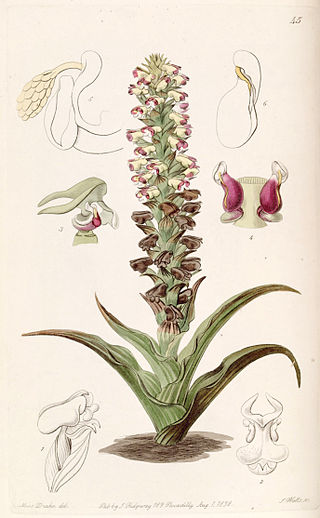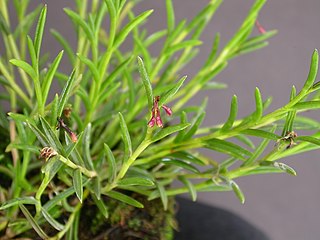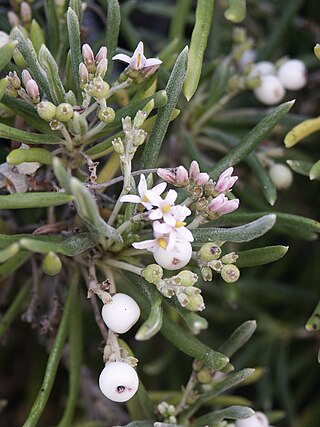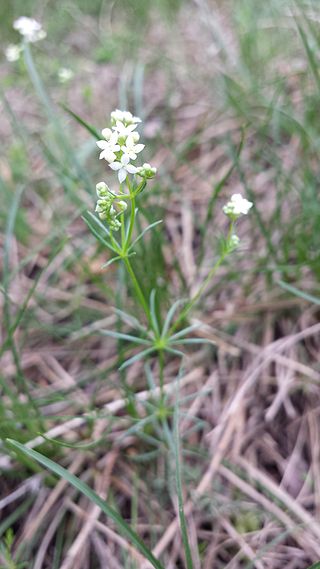
Stelis, or leach orchids, is a large genus of orchids, with perhaps 500 species. The generic name Stelis is the Greek word for 'mistletoe', referring to the epiphytic habit of these species. These mainly epiphytic plants are widely distributed throughout much of South America, Central America, Mexico, the West Indies and Florida. Stelis is abbreviated Ste. in the horticultural trade.

Dendrobium is a genus of mostly epiphytic and lithophytic orchids in the family Orchidaceae. It is a very large genus, containing more than 1,800 species that are found in diverse habitats throughout much of south, east and southeast Asia, including China, Japan, India, the Philippines, Indonesia, Australia, New Guinea, Vietnam and many of the islands of the Pacific. Orchids in this genus have roots that creep over the surface of trees or rocks, rarely having their roots in soil. Up to six leaves develop in a tuft at the tip of a shoot and from one to a large number of flowers are arranged along an unbranched flowering stem. Several attempts have been made to separate Dendrobium into smaller genera, but most have not been accepted by the World Checklist of Selected Plant Families.

Oncidium, abbreviated as Onc. in the horticultural trade, is a genus that, as of December 2023, contains about 340 species of orchids from the subtribe Oncidiinae of the orchid family Orchidaceae. It is distributed across tropical and subtropical America from Mexico, Central America and the West Indies to northern Argentina, with one species (O. ensatum) extending into Florida. Common names for plants in this genus include dancing-lady orchid and golden shower orchid.

Miltonia, abbreviated Milt. in the horticultural trade, is an orchid genus comprising twelve epiphyte species and eight natural hybrids. The miltonias are exclusively inhabitants of Brazil, except for one species whose range extends from Brazil into the northeast of Argentina and the east of Paraguay.

Olof Peter Swartz was a Swedish botanist and taxonomist. He is best known for his taxonomic work and studies into pteridophytes.

Cyrtochiloides, a genus of orchids described in 2001 by Norris H. Williams and Mark W. Chase, is designed to provide a small group of Neotropical epiphytes, previously included under a broad concept of Oncidium Sw., with a new, more accurate identity based on DNA.

Liparis, commonly known as widelip orchids, sphinx orchids or 羊耳蒜属 is a cosmopolitan genus of more than 350 species of orchids in the family Orchidaceae. Plants in this genus are terrestrial, lithophytic or epiphytic herbs with a wide range of forms. The flowers are usually resupinate and small to medium sized, yellow, yellow-green or purplish with spreading sepals and petals. The labellum is usually larger than the sepals and petals and is lobed, sometimes with a toothed or wavy margin and one or two calli at its base.

Tolumnia, is a genus in the family Orchidaceae. Previously known as the "equitant oncidiums," the species were segregated from the mega-genus Oncidium by Guido Braem in 1986. Dancing-lady orchid is a common name for some species in this genus.

Epidendrum secundum, one of the crucifix orchids, is a poorly understood reed stemmed species, which Dressler (1989) describes as "the Epidendrum secundum complex." According to Dressler, there are dozens of varieties, some of which appear to deserve species rank. Arditti and Ghani note that E. secundum has the distinction of bearing the longest seeds known in the Orchidaceae, 6.0 mm long. By comparison, the seeds of E. ibaguense are only 2.9 mm long.

Corycium is a genus of terrestrial orchids comprising some 14 species in Eastern and Southern Africa including 10 species native to the fynbos. In South Africa they are called monkshood orchids.

Oncidium ensatum, the Latin American orchid or Florida dancinglady orchid, is a species of orchid found in southern Florida, southern Mexico, Central America, Cuba, the Bahamas, and northwestern Venezuela.

Dendrobium linguiforme, commonly known as the thumbnail orchid, tick orchid or tongue orchid, is a plant in the orchid family Orchidaceae and is endemic to eastern Australia. It grows on trees or on rocks, with wiry, prostrate stems, prostrate, fleshy leaves and spikes of up to twenty white to cream-coloured flowers in early spring.

Epidendrum subsect. UmbellataRchb.f. (1861) is a subsection of section E. sect. PlanifoliaRchb.f. (1861) of subgenus E. subg. EpidendrumLindl. (1841) of the genus Epidendrum of the Orchidaceae. Plants of E. subsect. Umbellata differ from the other subsections of E. sect. Planifolia by producing inflorescences which are umbel-like. In 1861, Reichenbach recognized ten species in this subsection. Of these, nine are recognized with the same names by Kew :
Epidendrum spruceanum is an epiphytic reed-stemmed Epidendrum orchid native to the Tropical rainforest of Peru, Bolivia, and Brazil.

Ionopsis is a genus of flowering plants from the orchid family, Orchidaceae. It contains 6 currently accepted species, native to Latin America, the West Indies, and Florida.
- Ionopsis burchelliiRchb.f. - Brazil
- Ionopsis minutiflora(Dodson & N.H.Williams) Pupulin - Ecuador
- Ionopsis papillosaPupulin - Ecuador
- Ionopsis satyrioides(Sw.) Rchb.f. in W.G.Walpers - widespread across southern Mexico, Central America, the West Indies, and South America
- Ionopsis utricularioides(Sw.) Lindl. - widespread across southern Mexico, Central America, the West Indies, South America, and Florida
- Ionopsis zebrinaKraenzl. - Colombia

Jacquiniella is a genus of flowering plants from the orchid family, Orchidaceae. It is native to Mexico, Central America, the West Indies, and South America.

Strumpfia is a monotypic genus of flowering plants in the family Rubiaceae. The genus contains only one species, viz. Strumpfia maritima, which is found from southern Florida to northern Venezuela. Strumpfia maritima is also the only species in the tribe Strumpfieae. It is an evergreen shrub of coastal areas that rarely exceeds 1 m (3.3 ft) in height. Pride of Big Pine is a common name. Strumpfia was named by Nicolaus Jacquin in 1760 in his compilation entitled Enumeratio Systematis Plantarum. It was named for Christopher Strumpf, professor of chemistry and botany at Hall, in Magdeburg, and editor of Carl Linnaeus's Genera Plantarum.

Hillia is a genus of flowering plants in the family Rubiaceae. It has 24 species. All are indigenous to tropical America.

Neottia bifolia, common name southern twayblade, is a species of terrestrial orchid found in eastern Canada and the eastern United States.

Galium austriacum, the Austrian bedstraw, is a plant species in the Rubiaceae. It was first described in 1773 by Austrian botanist Nicolaus Jacquin as part of his Florae Austriaceae, the Austrian Empire in 1773 having been rather larger than the present-day Republic of Austria. The species is found in mountainous regions of present-day Austria, Switzerland, Italy, the Czech Republic, Slovakia, Hungary, and the former Yugoslavia.



















